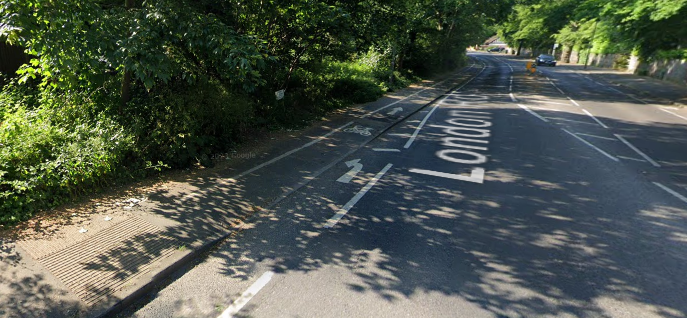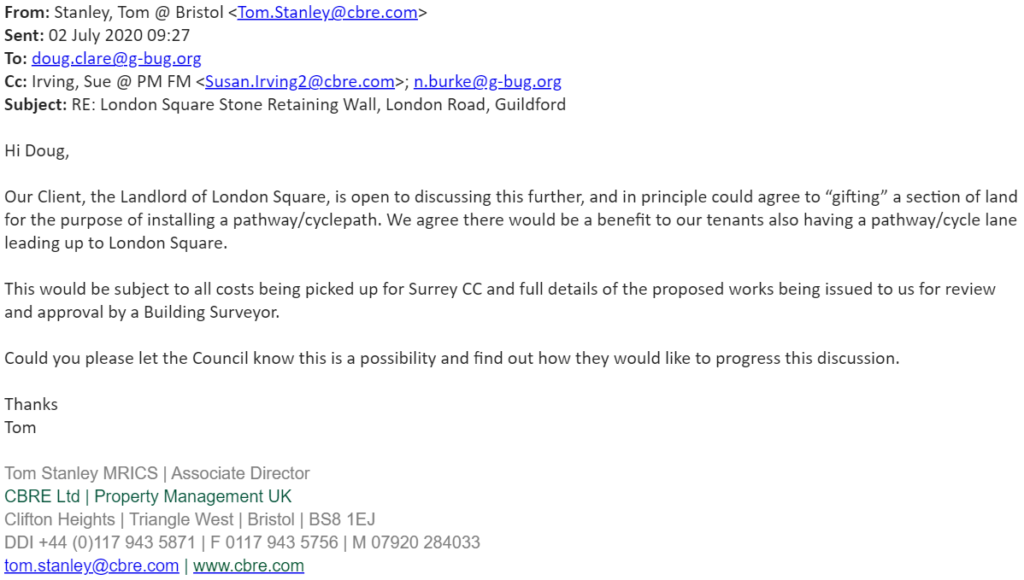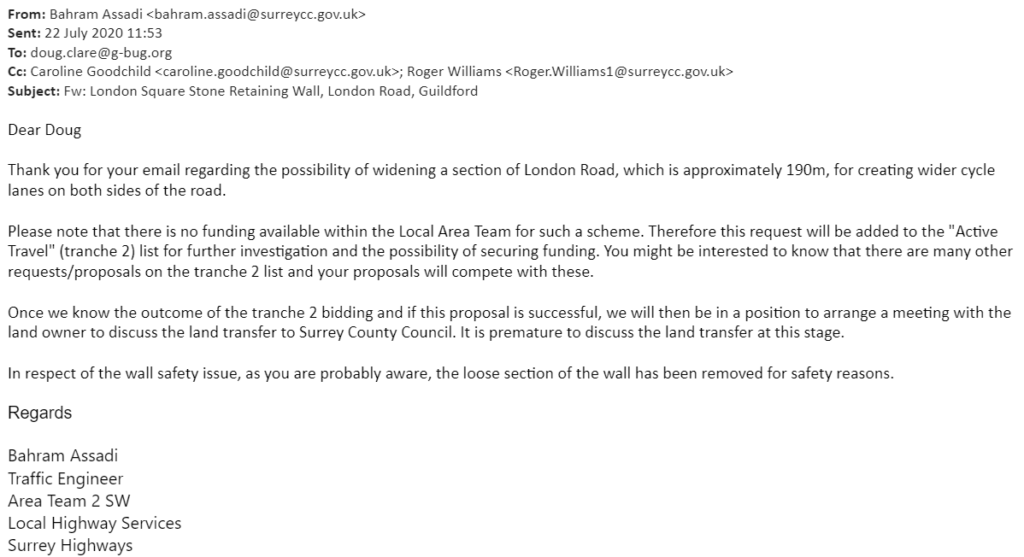March 2024
Contents
- Executive Summary
- Introduction
- Public Consultation Results – overall support
- Alternative survey – dismiss it
- Section 1 of the scheme
- Section 3 of the scheme
- Summary
1. Executive Summary
This report has illustrated the strength of public and consultee support for the London Road Active Travel Scheme, in the face of negative “propaganda” from one opposition group plus a tiny number of anti-cycling residents. It has illustrated the incoherence, incompleteness and flawed and contradictory nature of the Council’s recent decisions.
We urge the Council to now sanction as soon as possible the bike lane improvements already designed for section one, and to reverse the cancellation of section three whilst appropriate and available alternative options are properly and professionally reviewed.
The decisions recently taken, and thinking behind them, should be reconsidered, and put before the SCC scrutiny Committee.
Finally all future decisions on the London Road Active Travel scheme should be independently adjudicated on, away from political influence.
2. Introduction
The cycle lanes on the A3100 from New Inn Lane Burpham to York Road Guildford, are widely recognised as unfit for purpose. The need to segregate them from vehicle traffic has been the subject of study and many Council reports for more than 8 years (eg Guildford Cycling Plan, SCC 2015).
But the accident statistics keep piling up. Currently 2% of the traffic is bikes, whilst 30% of recorded collision injuries are to cyclists. There is a reportable cycling injury every three to six months on this section of road, a record going back over 10 years.
Should the cycle lanes be segregated from the vehicle carriage way the potential for a huge increase in cycling is evident.
Burpham is two miles from Guildford town centre, and a flat 10-15 minute cycle ride, possible by people well into their 60’s and 70’s.
Burpham is a neighbourhood of approximately 7000 people, living in mixed housing; 1 bed flats, 2 bed starter homes, 3 bed semi’s and modestly sized 4 bed homes. A family oriented place, with a significant proportion of people wishing to cycle, but scared to do so.
Improved cycle lanes on the London Road will not only deliver a safe route to the town centre, but will also link to existing segregated routes to Jacobs Well, Spectrum Leisure Centre, and Guildford Rail Station.
There are two secondary schools en-route, with almost 4000 students all hankering for their travel independence, almost as much as their parents are. In one of these schools the pupils surveyed themselves. 5% of them currently cycle to school, 40% said they would reconsider their travel method if the cycle lanes were improved.
So to read the Council press release on Surrey News (W/E 1/3/24) one would have thought the decisions on the latest Active Travel Project for the London Road had been to go ahead in full with the proposals.
“Tim Oliver Leader of SCC said “I am pleased to be taking forward a scheme that will deliver a step change in the local transport system to prioritise pedestrians and cyclists, in line with our active travel policies…………………I am confident that this work will see more people walking and cycling with confidence in this area…”.”.
The Council’s report however, (“Notice of Leader Decisions 27th Feb 2024, 10am”), notes that of the three phases of the London Road Active travel scheme, only one, upgrades to the Boxgrove roundabout, will be progressed.
Whilst the first stage, the mile from Burpham to Boxgrove will undergo further study, the third stage, the mile from Boxgrove to town, will be scrapped.
Thus an upgraded roundabout, will be marooned between two recognised inadequate current on road cycle routes, with their continuing accident histories. Neither of the London Road cycle lanes leading to, or coming from the roundabout, will be segregated.
The Council leader’s claims to be delivering a step change to the transport system when over 95% of the London Road Active travel project is still frozen or scrapped is either naively optimistic at best, or misleading at worst.
Likewise the Council report is in parts flawed, incoherent, incomplete, and contradictory, as is the thinking behind it.
GBUG, the Guildford Bicycle User Group, has been an active and constructive participant in all areas of the latest project but receives not one mention in the report. And whilst we welcome the various one off improvements now planned for pedestrian safety, we totally condemn the appalling total lack of improvement for the bike user.
The remainder of this document highlights the flaws in the Council report and thus the decisions recently taken. We urge the council now to approve as soon as possible the bike lane improvements already designed for section one, and to reverse the cancellation of section three whilst appropriate and available alternative options are properly reviewed. All future decisions here should be independently adjudicated on, away from political influence.
In the meantime, on the basis of this document, GBUG calls for the decisions recently taken to be formerly suspended and then reviewed by the SCC scrutiny committee.
3. Public Consultation Results – overall support
It is known that all major infrastructure projects involve change which naturally causes concern and opposition. In many cases once such projects are implemented the majority view turns to “Why didn’t we do this earlier?”.
Cycling infrastructure projects are no different. A scientific paper (Timmons et al, 2024) has concluded that public support for cycle infrastructure grows after implementation and that such projects do have positive effects on walking and cycling rates, as well as business activity. They also reduce traffic congestion.
For all three sections of the London Road Active Travel Scheme (plus or minus 1-2%), 50% of all respondents to the SCC public engagement survey were in favour of the scheme, way ahead of the 30% against. This despite heavily negative mis-information being actively and enthusiastically spread by a small number of local activists calling themselves LRAG (London Road Action Group).
In addition to the backing of the public and Surrey Highways professional staff, all formal consultees engaged also provided their support, including:
- George Abbot School (2.5k students),
- Guildford High School (1.5k students),
- Surrey Coalition of Disabled People/Surrey Vision Action Group,
- Family Voice (Parent and Carer Forum),
- Residents of Clockhouse Retirement Home,
- Emergency Services (South East Coast Ambulance Service, Surrey Fire and Rescue Service, Surrey Police)
- Stagecoach Bus Company.
In the face of natural initial nervousness about infrastructure change and a high profile negative campaign by an in effect anti-cycling group, a 50% public support vote and total support from all consultees should have been more than what was required to proceed with the project. With post event support only likely to grow further.
Furthermore the difference of just one or two percentage points between the support levels for the three sections individually, indicates strong consistent support for the scheme as a whole. And clearly the scheme will only encourage more active travel if it is delivered as a whole. To use these one or two percentage point differences in public support as a rationale for different decisions on each, is stretching a mathematical point beyond credulity.
4. Alternative survey – dismiss it
The group that formed themselves in opposition to the scheme called themselves LRAG. They developed an alternative survey that was so inappropriate that its publication by just one or two members caused LRAG to split.
This tiny splinter group went ahead with their own survey despite a professional market researcher being approached and commenting that the alternative was “horrendous, unprofessional and biased propaganda (see Figure 1).”

Figure 1 Facebook comment from Julia Karant
The disclaimer on the alternative survey results includes a sentence absolving the authors of any need to ensure the accuracy, completeness or sufficiency of it (see Figure 2).

Figure 2 Extract from London Road Active Travel Scheme results summary
Despite this, the Council report continues to quote the survey1 as valid input towards its decisions, and the Leader quotes it on air justifying the same , when the authors do not stand by the accuracy of the survey themselves. Therefore, the survey should have been, and should now be, completely discounted. Instead, total reliance should be put on the Surrey County Council independently led and verified engagement survey, alongside the professionally drawn up active travel plans.
5. Section 1 of the scheme
The main reasons2 given for the delay and re-review of Section 1 of the scheme are:
1) The safety of shared use paths in the design.
2) Concerns over road widths/pinch points.
With respect to shared use paths the Council report fails to point out that:
a) There are significant lengths of existing shared cycle/pedestrian paths already on the London Road. These are all poorly signed and maintained with frequent dangerous transitions on and off the busy carriageway (see Figure 3). Additionally there are current inappropriate areas of shared use path, for example southbound running past Abbotswood where the vehicle carriageway width is at its greatest, whilst the shared cycle/ pedestrian path is at its narrowest.

Figure 3 Cycle lane transition from on-road to on-footpath along London Road
b) Despite there being many instances of shared use path in and around this area3 as well as across the whole of Surrey, there is minimal incidents of cycle/pedestrian collision. Of over 3,630 road traffic collisions in Surrey in 2022 recorded by Surrey Police, only 3 were between pedestrians and cyclists. On this stretch of the London Road, despite cycles representing only 2% of the current traffic 30%, of reported injuries are to cyclists (London Road Active Travel website). Over the last five years there have been:
a. 14 reported car to pedal cycle collisions,
b. 5 motor vehicle to pedestrian collisions and
c. no pedal cycle to pedestrian collisions.
The need to segregate cycle lanes from vehicle lanes remains clear, whilst the fears surrounding collision potential on shared use paths between cyclists and pedestrians are unfounded. Furthermore, the new design will improve the safety of such pedestrian/cycle shared areas making them coherently positioned, properly and clearly signed and designed to LTN 1/20 requirements – none of which is the case with the existing shared lanes.
With respect to vehicle lane widths and pinch points:
a) The new design does not reduce vehicle lane widths from those existing now, in fact in some key areas vehicle lane width will be increased. Thus lane width issues are not as a result of the new design, but already exist today.
b) The pinch points also currently exist today, with the bail out for vehicle traffic being into an unsegregated cycle lane, with potentially a cyclist in it. Tim Oliver’s BBC Radio Surrey pronouncement (1/3/24) that he is concerned at these points that 2 HGVs might “tip into each other”, indicates he thinks it preferable that one HGV may “tip” into a cyclist.
c) Segregating the existing cycle lane can only improve cyclists’ protection at these pinch points, with kerbing providing a further signal for vehicle traffic to slow and take extra care, whilst also providing more of a physical barrier than a painted white line. And if extra vehicle signage and reduced traffic speed is required to further enforce this extra vehicle care, so be it.
d) Existing pinch points should be addressed by other measures such as reduced speed limits to 20 MPH.
In these challenging engineering areas the Council must now rely on the professional expertise of its own Highway Engineers and consultants, adhering to specification requirements, getting behind the undoubted improvements offered by the latest design for section one. Furthermore the Council should beware of sacrificing the good for the perfect, by listening to biased, illinformed and blinkered objection.
The latest design of section one, to Highway specifications, should now be approved asap.
6. Section 3 of the scheme
A part justification for the cancellation of section 3 of the London Road Active Travel scheme is given as below;
“there was feedback that there exists an alternative cycle way, which although not as convenient as
that proposed in section one, does offer a cyclist the ability to continue their journey through this
part of the corridor off the main road”4.
In reality this cycle path is unacceptable as an alternative given it is:
a) Shared by pedestrians (including many dog walkers) and cyclists; the Council’s continuing part concern about section 1.
b) Certainly too narrow for two-way cycle traffic plus pedestrian shared use.
c) It is currently inadequately signed and poorly maintained.
d) It is unlit, and thus dangerous and inadvisable for anyone to use at night. Especially High School girls cycling to and from home in winter.
e) The path does not continue to Guildford High School or beyond without a massive detour.
Where is the Surrey Highways report that recommends this park path as an acceptable alternative cycling route, to the extent that the Council’s report uses it to part justify cancellation of section 3 of the London Road Active Travel plan?
Furthermore the report indicates the ATE money set aside for section 3 will now be allocated elsewhere. If the Council is serious in its intention that the park path be an off-road alternative for cyclists, the section 3 money in place must be retained for its upgrade.
Additionally, the main concern with the new design of section three is the narrowness of available road width by the High School to keep a direct cycle lane segregated. Completely ignored, undeveloped and unmentioned however, are prior discussions initiated by GBUG, between SCC Highways and the owners of London Square, opposite the High School, concerning the potential gifting of land to give more available width.
The emails shown below (see Figure 4 and Figure 5) illustrate the potential, but lack of SCC money in 2020 to follow through. There is now of course ATE (Active Travel England) money to use, and these discussions must be picked up in earnest once again.
Given the above points, the cancellation of phase 3 of the scheme should be reversed immediately, and the alternatives should be quickly, professionally and thoroughly evaluated. Whilst this reevaluation is taking place there should be an immediate speed limit of 20 mph implemented along this stretch, to reduce risk to the unsegregated bike lane users, with other traffic calming measures also considered.

Figure 4 Email from London Square to GBUG

Figure 5 Email from Surrey County Council to GBUG
7. Summary
This report has illustrated the strength of public and consultee support for the London Road Active Travel Scheme, in the face of negative “propaganda” from one opposition group plus a tiny number of anti-cycling residents. It has illustrated the incoherence, incompleteness and flawed and contradictory nature of the Council’s recent decisions.
We urge the Council to now sanction as soon as possible the bike lane improvements already designed for section one, and to reverse the cancellation of section three whilst appropriate and available alternative options are properly and professionally reviewed.
The decisions recently taken, and thinking behind them, should be reconsidered, and put before the SCC scrutiny Committee.
Finally all future decisions on the London Road Active Travel scheme should be independently adjudicated on, away from political influence.
- Paragraph 25 and 33 of the Notice of Meeting Leader Decisions, 27th February 2024 ↩︎
- Paragraph 37 33 of the Notice of Meeting Leader Decisions, 27th February 2024. ↩︎
- Along Parkway, Stoke Road, Clay Lane, around Sutherland Memorial Park…… ↩︎
- Paragraph 38 of the Notice of Meeting Leader Decisions, 27th February 2024 ↩︎
